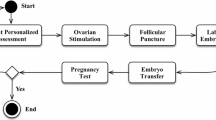Abstract
The intra uterine insemination (IUI) is an assisted reproductive technique, enabling infertile couples to achieve pregnancy. We propose the variation of information theoretic network approach which uses human expert guidance to knowledge mining and suggest some possible modifications to IUI treatment plan in order to improve overall success rates. The information theoretic network algorithm employs the statistic significance to construct the network. We propose a new algorithm by adding up the medical significant criteria from human expert to construct the information theoretic network. We found that this new algorithm give us more reasonable result to human expert than the original information theoretic approach. The reliability of the knowledge got from this new algorithm is more acceptable than the original algorithm. And also human experts accept and satisfy the knowledge got from this new algorithm than the original algorithm. This shows that using human expert guidance with the original information theoretic approach to be the new algorithm can give us better result.
Similar content being viewed by others
References
Kantardzic M (2003) Data mining: Concepts, models, methods, and algorithms, ed. E.i.C. Stamatios V Kartalopoulos. USA: IEEE press
Berry MJA, Linoff GS (2000) Data mining techniques and algorithms. In: Elliott RM (ed) Mastering data mining. Wiley, USA
Groth R (2000) Data mining : building competitive advantage. Prentice-Hall, New Jersey
Han J, Kamber M (2001) Data mining: concepts and techniques. Morgan Kaufmann Publishers, San Francisco
Handmer A (2003) Fertility treatment produces tiny miracles. In: The University of Sydney News, Sydney, p 8
Formosa M, Brincat MP (1994) Infertility. In: Brincat MP (ed) Understanding common disorders in reproductive endocrinology. Wiley West England, p 67–86
Brudenell M et al (1989) Gynaecology by ten teachers. 15th edn, ed. G. Chamberlain. 1989: Edward Arnold.
Agrawal R, Imielinski T, Swami A (1993) Mining Association rules between sets of items in large databases. In: In Proceedings of the ACM SIGMOd conference on management of data, Washington
Agrawal R, Srikant R (1994) Fast algorithms for mining association rules. In: Proceedings of the 20th international conference very large data bases
Liu B et al (2000) Analyzing subjective interestingness of association rules. IEEE Intell Syst 15(5):47–55
Tseng S-M (2001) Mining association rules with interestingness constraints in large databases. Int J Fuzzy Syst 3(2):415–421
Silberschatz A, Tuzhilin A (1995) On subjective measures of interestingness in knowledge discovey. In: Proceedings of the first international conference on knowledge discovery and data mining. Montreal
Wu X et al (2001) Learning Bayesian-network topologies in realistic medical domains, in ISMDA, p 302–308
Taylor M (1996) Discovering multi-level classification rules in platelet transfusion databases. University of Maryland
Salzberg S (1997) On comparing classifiers: pitfalls to avoid and a recommended approach, in data mining and knowledge discovery. Kluwer Boston, pp 312-327
Quinlan JR (2001) Data mining tools See5 and C5.0. RuleQuest
Mehta M, Agrawal R, Rissanen J (1996) SLIQ: a fast scalable classifier for data mining. In: Proceedings of the fifth international conference on extending database technology. Avignon, France
Cheeseman P, Stutz J (1996) Bayesian classification (autoclass): theory and results. In: Uthurasamy RS (ed) Advances in knowledge discovery and data mining, AAAI Press
Maimon O, Kandel A, Last M (1999) Information theoretic fuzzy approach to knowledge discovery in databases. In: Chawdhry PK, (ed) Advances in soft computing – engineering design and manufacturing. Springer-Verlag, London, pp 315–326
Maimon O, Last M (2000) Knowledge discovery and data mining, the info-fuzzy network (IFN) methodology. Kluwer, Norwell
Maimon O, Last M (2001) Knowledge discovery and data mining : the info-fuzzy network (IFN) Methodology. Kluwer, Netherlands p 168
Last M, Klein Y, Kandel A (2001) Knowledge discovery in time series databases. IEEE Trans Syst Man Cybern 31(1):160–169
Fayyad U, Piatetsky-Shapiro G, Smyth P (1996) Advances in knowledge discovery and data mining. AAAI/MIT Press, Cambridge
Tsai Y-S et al (1997) An expert-guided decision tree construction strategy: an application in knowledge discovery with medical databases. In: 1997 AMIA (American Medical Informatics Association) Fall Symposium.
Lemay P (1999) Information theory: a primer
Author information
Authors and Affiliations
Corresponding author
Rights and permissions
About this article
Cite this article
Kooptiwoot, S., Salam, M. IUI mining: human expert guidance of information theoretic network approach. Soft Comput 10, 369–373 (2006). https://doi.org/10.1007/s00500-005-0496-6
Published:
Issue Date:
DOI: https://doi.org/10.1007/s00500-005-0496-6




